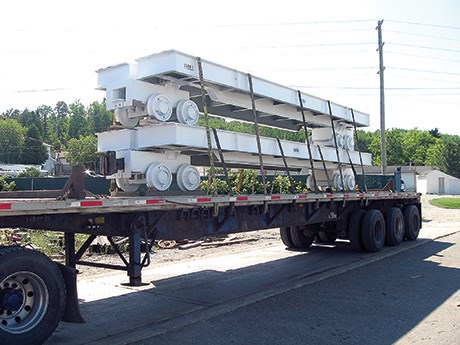No shortage of work for New Liskeard manufacturer
Wabi Iron & Steel Corp. is helping to double gold production at the Tahoe Resources Bell Creek mine northeast of Timmins.
The New Liskeard company is supplying the hoisting infrastructure for an $80-million project to deepen the Bell Creek shaft from 300 metres to about 1,080 metres. Slated for completion in 2018, the project will access a deeper mineral resource that’s expected to double annual gold production from the Bell Creek Mine to 80,000 ounces and provide the opportunity to extend the mine life.
A more-than-century-old mining manufacturer and foundry, Wabi is fabricating the shaft steel, guides, skips, cage, loading system and sheave wheels for the project. “It’s a comprehensive package,” said Wabi president Stan Gorzalczynski, who credits Wabi’s expertise for its selection as Tahoe’s project supplier. “They were looking to partner with a supplier that had experience and engineering capability and we were the competitive choice.”
A shaft communication system with a slack rope monitoring system is part of the equipment package for Bell Creek. The enhanced safety device has become mandatory on new mine cages in Ontario, said Steve Hill, Wabi’s vice-president of business development. “It’s one of the first slack rope monitoring systems going into Ontario under the new requirements,” he said. The system will warn the hoist room of any slack rope condition. “If the cage is lowered and something happens to cause it to jam up in the shaft and the rope goes a little bit slack as a result, it would provide the warning or even trip the hoist so you don’t have the rope paying out onto the top of the cage,” Hill said.
If a slack rope condition was caused by a jammed conveyance, the conveyance could dislodge and all that slack rope would allow a free fall, ending with a sudden stop that could break the hoist rope, Gorzalczynski explained. “It’s not a common issue in the mine shaft, but it’s one of those situations that would be catastrophic if it did occur,” he said. “You need to have the safety features there just in case.” The shaft construction represents about 18 months of work for Wabi, he estimates.
While the Bell Creek project mirrors much of the work Wabi has been doing since 1907, the company is also involved in some cutting edge technology projects.
At Agnico Eagle’s Goldex Mine in Val-d’Or, Wabi designed equipment for testing synthetic hoist ropes for the Canadian Mining Industry Research Organization (CAMIRO). As mines dig deeper, lighter and more flexible synthetic hoist ropes may eventually replace heavy steel wire ropes for mine hoisting.
CAMIRO wanted to assess the ability of the synthetic hoist ropes to withstand cyclic loading, Gorzalczynski said. “They didn’t have muck to hoist, so they needed some kind of method of mimicking the loading and unloading of skips,” he said. Wabi converted existing skips in the shaft to a cargo deck with a ballast car that could be moved on and off. “That gave the cyclic loading to the rope.”
Deep below Sudbury, in Vale’s Creighton mine, Wabi helped SNOLAB, the underground physics and neutrino laboratory, to redesign a rail-based instrument carrier. “The neutrino lab has to live with moving its equipment along the same tracks as production haulage for the mine,” said Gorzalczynski. “They’re transporting very expensive pieces of equipment.”
SNOLAB enlisted Wabi for its expertise, knowledge and engineering capabilities to design bogies that are ultra light-weight and strong. Wabi supplied a relatively conventional bogie system for the instrument carrier. “But it’s much tighter than the old flat cars that they had,” Gorzalczynski said. “I think we can pretty well guarantee that this new equipment will track quite nicely.”
The rail carrier project was familiar terrain for Wabi. “One things we’ve been doing for over 100 years is building mine cars, so it was a good fit,” said Hill.
These three recent projects attest to Wabi’s diversity and expertise in mine manufacturing and metallurgy.
Wabi employs about 60 people, including mechanical and metallurgical engineers, welders, machinists, pattern makers and tool and die makers. The company is also finishing off an order of skips and cages for a mine in Peru.


